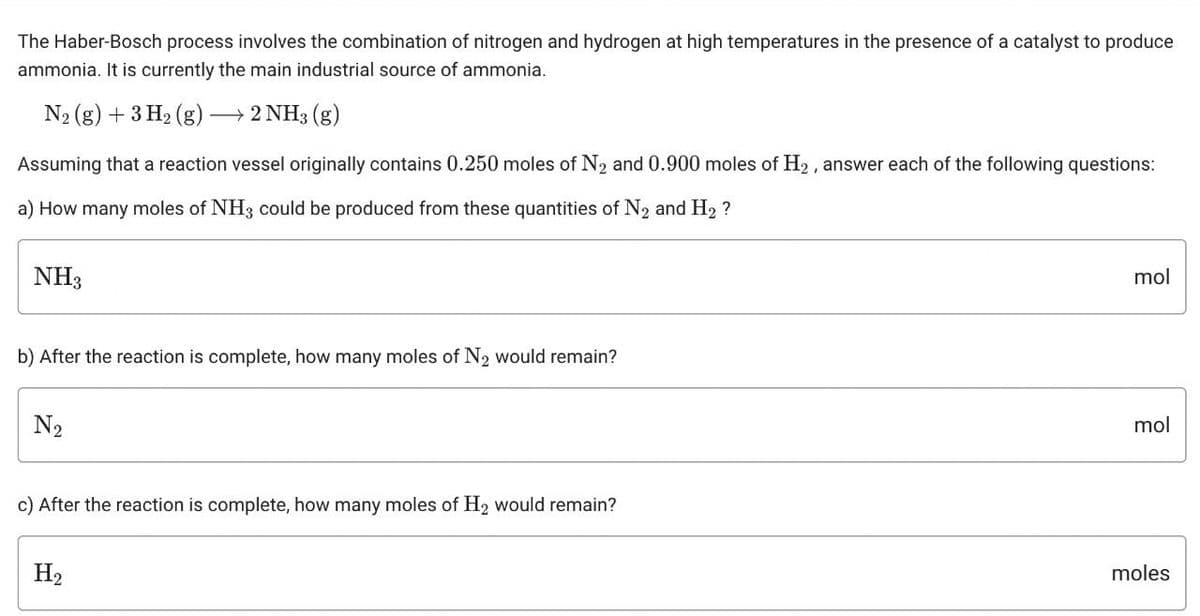The Haber-Bosch process involves the combination of nitrogen and hydrogen at high temperatures in the presence of a catalyst to produce ammonia. It is currently the main industrial source of ammonia. N2 (g) + 3 H2 (g) – →2 NH3 (g) Assuming that a reaction vessel originally contains 0.250 moles of N2 and 0.900 moles of H2, answer each of the following questions: a) How many moles of NH3 could be produced from these quantities of N2 and H2 ? NH3 mol b) After the reaction is complete, how many moles of N2 would remain? N2 mol c) After the reaction is complete, how many moles of H2 would remain? H2 moles
The Haber-Bosch process involves the combination of nitrogen and hydrogen at high temperatures in the presence of a catalyst to produce ammonia. It is currently the main industrial source of ammonia. N2 (g) + 3 H2 (g) – →2 NH3 (g) Assuming that a reaction vessel originally contains 0.250 moles of N2 and 0.900 moles of H2, answer each of the following questions: a) How many moles of NH3 could be produced from these quantities of N2 and H2 ? NH3 mol b) After the reaction is complete, how many moles of N2 would remain? N2 mol c) After the reaction is complete, how many moles of H2 would remain? H2 moles
Chemistry & Chemical Reactivity
9th Edition
ISBN:9781133949640
Author:John C. Kotz, Paul M. Treichel, John Townsend, David Treichel
Publisher:John C. Kotz, Paul M. Treichel, John Townsend, David Treichel
Chapter4: Stoichiometry: Quantitative Information About Chemical Reactions
Section: Chapter Questions
Problem 15PS: The reaction of methane and water is one way to prepare hydrogen for use as a fuel: CH4(g) + H2O(g) ...
Related questions
Question
100%
ASAP please

Transcribed Image Text:The Haber-Bosch process involves the combination of nitrogen and hydrogen at high temperatures in the presence of a catalyst to produce
ammonia. It is currently the main industrial source of ammonia.
N2 (g) + 3 H2 (g) → 2 NH3 (g)
Assuming that a reaction vessel originally contains 0.250 moles of N2 and 0.900 moles of H2 , answer each of the following questions:
a) How many moles of NH3 could be produced from these quantities of N2 and H2 ?
NH3
mol
b) After the reaction is complete, how many moles of N2 would remain?
N2
mol
c) After the reaction is complete, how many moles of H2 would remain?
H2
moles
Expert Solution
This question has been solved!
Explore an expertly crafted, step-by-step solution for a thorough understanding of key concepts.
Step by step
Solved in 5 steps

Knowledge Booster
Learn more about
Need a deep-dive on the concept behind this application? Look no further. Learn more about this topic, chemistry and related others by exploring similar questions and additional content below.Recommended textbooks for you

Chemistry & Chemical Reactivity
Chemistry
ISBN:
9781133949640
Author:
John C. Kotz, Paul M. Treichel, John Townsend, David Treichel
Publisher:
Cengage Learning

Chemistry & Chemical Reactivity
Chemistry
ISBN:
9781337399074
Author:
John C. Kotz, Paul M. Treichel, John Townsend, David Treichel
Publisher:
Cengage Learning

General Chemistry - Standalone book (MindTap Cour…
Chemistry
ISBN:
9781305580343
Author:
Steven D. Gammon, Ebbing, Darrell Ebbing, Steven D., Darrell; Gammon, Darrell Ebbing; Steven D. Gammon, Darrell D.; Gammon, Ebbing; Steven D. Gammon; Darrell
Publisher:
Cengage Learning

Chemistry & Chemical Reactivity
Chemistry
ISBN:
9781133949640
Author:
John C. Kotz, Paul M. Treichel, John Townsend, David Treichel
Publisher:
Cengage Learning

Chemistry & Chemical Reactivity
Chemistry
ISBN:
9781337399074
Author:
John C. Kotz, Paul M. Treichel, John Townsend, David Treichel
Publisher:
Cengage Learning

General Chemistry - Standalone book (MindTap Cour…
Chemistry
ISBN:
9781305580343
Author:
Steven D. Gammon, Ebbing, Darrell Ebbing, Steven D., Darrell; Gammon, Darrell Ebbing; Steven D. Gammon, Darrell D.; Gammon, Ebbing; Steven D. Gammon; Darrell
Publisher:
Cengage Learning

Chemistry
Chemistry
ISBN:
9781305957404
Author:
Steven S. Zumdahl, Susan A. Zumdahl, Donald J. DeCoste
Publisher:
Cengage Learning


Chemistry: An Atoms First Approach
Chemistry
ISBN:
9781305079243
Author:
Steven S. Zumdahl, Susan A. Zumdahl
Publisher:
Cengage Learning